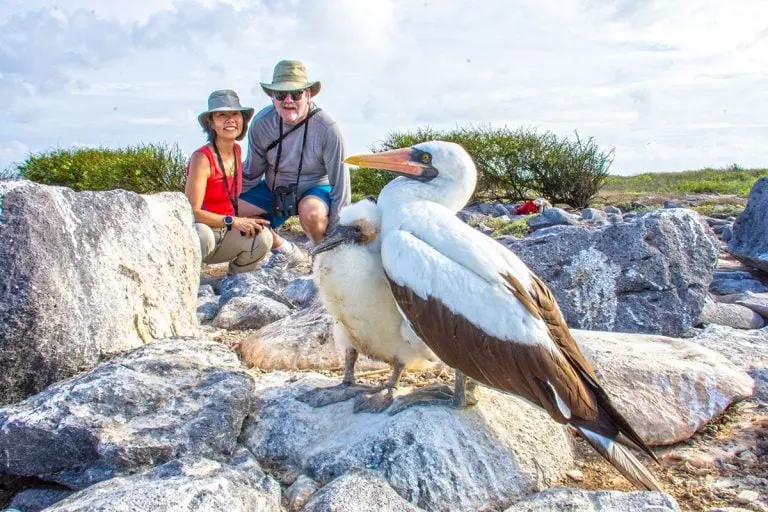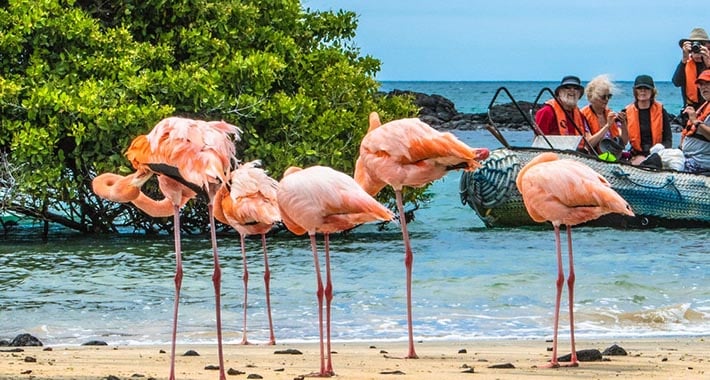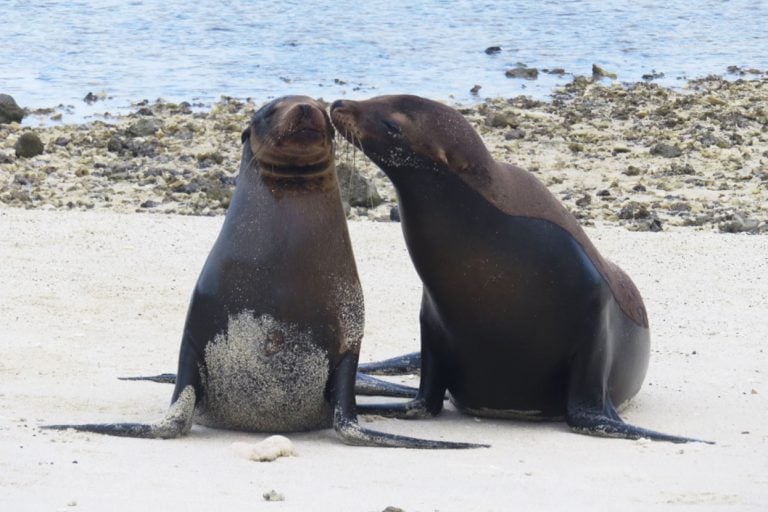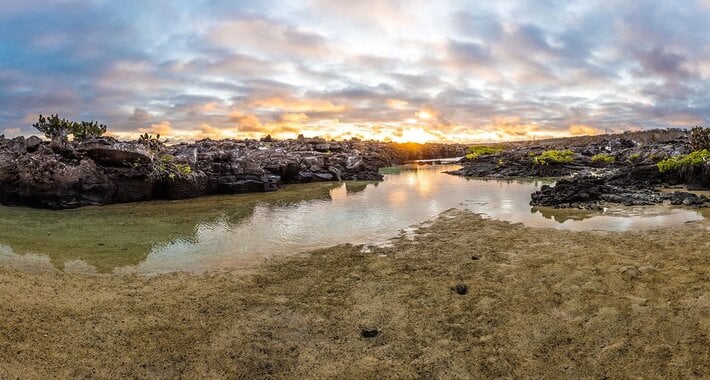Galapagos Tips & Information | < 1 MIN READ
Monthly Overview of the Galapagos Islands: Are you unsure about the best time to visit?
Published on November 18, 2016

What time of year is ideal for visiting the archipelago? Despite being dubbed the perfect summer getaway, you should read our month-by-month guide to Galapagos before deciding when to travel.
Choosing Your Visit Dates: Monthly-by-Month Galapagos
January
- Around the islands, land bird eggs start to show up, usually after the first rain.
- The start of the hot, rainy season.
- On Galapagos beaches, green sea turtles come out of the water to lay their eggs, and the land iguana’s reproductive cycle starts.
- Española (Hood) Island’s well-known Christmas iguanas start to take on the green, red, and black hues that have given them their name.
February
- The peak time for Galapagos doves to nest
- Floreana Island’s larger flamingos start building their nests.
- From April through May, water temperatures remain at or around 25°C (77°F), which is their high.
- Santa Cruz Island’s marine iguanas start to procreate.
- Breeding of Bahamas pintail ducks
March
- Wet landings at popular tourist destinations including Puerto Egas, Gardner Bay, and Bartolome may be challenging due to deep swells.
- Determined by high humidity, warm air temperatures (up to 30°C [86°F]), bright sun, and tropical showers.
- Scuba divers may swim alongside penguins and enormous schools of tropical fish at locations like Punta Vicente Roca.
- On Fernandina Island, marine iguanas start their nesting season. After a several-month trip, the Galapagos albatross lands on Española Island, which is well-known for its warm waters, which make snorkeling ideal.
April
- The season for giant tortoises to hatch ends.
- Less rain, but the islands’ rich green hue endures.
- An excellent view for scuba divers.
- On the beach, green sea turtle eggs start to hatch. At night, little turtles may be seen strolling along the beaches.
- Huge numbers of Galapagos albatrosses arrive at Española. The season of mating begins.
- On Isabela, land iguana offspring start to hatch.
May
- The breeding season for Blue-footed boobies, who are renowned for their highly ritualized dance, begins.
- Galapagos albatross breeding season begins; sea turtle hatchlings continue along Galapagos beaches.
- Known for showcasing the greatest features of both seasons, combining elements of the rainy and dry (this is also true for April and June).
- The Ban-rumped Storm Petrels begin their annual breeding season.
The Galapagos Islands are best visited at any time of year; book your next voyage on Yacht La Pinta!
Ahead of your Galapagos excursion, get ready!
June
- The Galapagos Islands are a transit area for migratory birds and other cetacean species, including humpback whales.
- Southeast trade winds bring about higher waves and currents.
- When there is garúa fog, the dry season starts.
- To nest, female giant tortoises move to the lowlands of Santa Cruz.
- On North Seymour, male superb frigatebirds show off their scarlet pouches during the mating season.
July
- The season when American oystercatchers nest.
- The water cools to less than 21°C (68°F). We advise wearing wetsuits.
- Lava lizards’ breeding season, which lasts until November.
- A time of year when many seabirds, such as the flightless cormorants and the blue-footed booby, which are renowned for their amazing courtship displays, breed.
- The Galapagos seas are home to a large number of cetaceans, especially around the western coasts of Isabela and Fernandina.
- Blue-footed booby nests can produce eggs, chicks, juveniles, and young adults.
August
- Genovesa is the nesting season for swallow-tailed gulls and Nazca boobies.
- At around 18°C (64°F), the water is at its lowest point and richest.
- The Galapagos hawks’ mating season on the islands of Santiago and Española.
- Signals the shorebirds’ migratory arrival on the island. They remain until around March.
- Sealion pups start to show up all around the islands, but especially in the western and central islands.
- Female giant tortoises ascend once more to the Santa Cruz mountains.
- The strongest ocean currents cause rough waves with powerful surges near the southern and western coasts.
September
- During their frequent visits to Bartolome, the Galapagos penguins are most active.
- The apex of the dry season, or garúa.
- The climax of the winter season.
- Most seabirds are in the process of building their nests.
- When sea lions mate at their peak. It is common for men to fight.
October
- On Isabela, blue-footed booby chicks sway over Española and Punta Vicente Roca.
- Giant tortoises are still producing eggs throughout this season.
- The lava heron nesting season starts and lasts until March.
- Distinguished by breathtaking dawns, clear peaks, and dense fog at lower elevations.
- The fur seals of Galapagos starts mating.
- Cloudy days are common. The garua fog, especially in the morning, covers many coastlines.
November
- The season for brown noddy reproduction starts.
- There are less southeast trade winds, calm seas, and a gradual rise in temperature.
- The band-rumped storm petrels’ second fruitful season gets underway.
- Sea lions are still breeding, and they’re especially busy on the eastern islands.
- Sealion puppies amuse divers who are anxious to explore these goggled animals in the sea, especially around Champion Island.
- Due to its transitional nature, it is renowned for its great weather.
December
- The green sea turtles’ mating season starts.
- Galapagos turns “green” as the rainy season begins.
- Massive tortoise eggs start to hatch; young can be observed until April.
- The juvenile Galapagos albatrosses start to fly.
- As the summertime approaches, sunlight determines the weather.
How can you tell what suits you the best?
RELATED STORIES

Galapagos Tips & Information | < 1 MIN READ
What are the best birds to see in the Galapagos?
Published on October 15, 2019
There are a grand total of 56 native species of birds in the Galapagos that...

Galapagos Wildlife | < 1 MIN READ
Six Stunning Ways Galapagos Island Animal Mothers Nurture Their Young
Published on May 8, 2018
Join us in this blog as we investigate the amazing ways that these BIG15 famous...

Galapagos History | < 1 MIN READ
Guy Fawkes on the Galapagos Islands: Never forget the November “Finch”…
Published on November 5, 2017
Regarding the title of our site, our ‘finch’ is a pun on the words found...

Galapagos History | < 1 MIN READ
A Unique 6-Day Insular Inspiration Session with Charles Darwin on Santiago Island!
Published on October 11, 2017
The Galapagos Islands honor the discoveries made by Charles Darwin Charles Darwin’s travels to the...

Galapagos News | < 1 MIN READ
Just now, this arrived! On Fernandina Island, the La Cumbre Volcano is now erupting!
Published on September 4, 2017
The shield volcano known as La Cumbre, which is nearly completely composed of flowing lava,...
Manage Cookie Consent
To provide the best experiences, we use technologies like cookies to store and/or access device information. Consenting to these technologies will allow us to process data such as browsing behavior or unique IDs on this site. Not consenting or withdrawing consent, may adversely affect certain features and functions.
Functional Always active
The technical storage or access is strictly necessary for the legitimate purpose of enabling the use of a specific service explicitly requested by the subscriber or user, or for the sole purpose of carrying out the transmission of a communication over an electronic communications network.
Preferences
The technical storage or access is necessary for the legitimate purpose of storing preferences that are not requested by the subscriber or user.
Statistics
The technical storage or access that is used exclusively for statistical purposes.
The technical storage or access that is used exclusively for anonymous statistical purposes. Without a subpoena, voluntary compliance on the part of your Internet Service Provider, or additional records from a third party, information stored or retrieved for this purpose alone cannot usually be used to identify you.
Marketing
The technical storage or access is required to create user profiles to send advertising, or to track the user on a website or across several websites for similar marketing purposes.
Manage Cookie Consent
We use cookies to optimize our website and our service.
Functional Always active
The technical storage or access is strictly necessary for the legitimate purpose of enabling the use of a specific service explicitly requested by the subscriber or user, or for the sole purpose of carrying out the transmission of a communication over an electronic communications network.
Preferences
The technical storage or access is necessary for the legitimate purpose of storing preferences that are not requested by the subscriber or user.
Statistics
The technical storage or access that is used exclusively for statistical purposes.
The technical storage or access that is used exclusively for anonymous statistical purposes. Without a subpoena, voluntary compliance on the part of your Internet Service Provider, or additional records from a third party, information stored or retrieved for this purpose alone cannot usually be used to identify you.
Marketing
The technical storage or access is required to create user profiles to send advertising, or to track the user on a website or across several websites for similar marketing purposes.